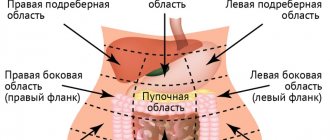Causes of abdominal pain
Abdominal pain is accompanied by different symptoms and can be caused by various diseases, so you will not be able to independently determine the causes of its occurrence. Only an experienced doctor will be able to establish an accurate diagnosis and the causes of such pain after examining the patient.
There are situations when the lower abdomen hurts very badly and feels nauseous; in addition, a person vomits and the temperature rises. All this indicates that it is necessary to urgently call emergency help, since the presence of these symptoms may indicate injury or the development of diseases that seriously threaten the health and even the life of the patient.
In cases where the stomach hurts and feels nauseous, this may indicate the development of gastrointestinal diseases; in addition, abdominal pain can be caused by diseases of the urinary system or genital organs, which are located in the abdominal cavity. Malfunctions in the operation of any of them can cause not only discomfort, but also pain in the abdominal area, often accompanied by nausea and sometimes vomiting.
Most often, the appearance of abdominal pain causes the patient to suspect poisoning, especially if the discomfort appeared soon after eating. Poisoning with low-quality food products, which contain many harmful chemical compounds, can cause quite severe pain.
If you feel nauseous or have discomfort in your stomach, you need to examine yourself yourself and determine the symptoms that need to be reported to the doctor so that he can quickly and accurately diagnose. The presence of vomiting, severe pain in the abdominal area and an increase in temperature are the first symptoms in which an ambulance should be urgently called.
If you have abdominal pain, you should not put off visiting a doctor. Then you will be able to determine the causes of the symptoms and begin treatment in the early stages, which will ensure its high effectiveness.
Causes of abdominal pain and nausea
Often, abdominal discomfort and nausea indicate that pathological processes are occurring in the body. Pain is a signal of irritation of the nerve endings located in the gastrointestinal tract. Nausea usually indicates that toxins have entered the body.
Experts identify the following causes of abdominal pain and nausea:
Inflammation of the appendix (part of the cecum). Pathology of the pelvic organs in women. Liver dysfunction. Hernia. Kidney failure. Food poisoning. Damage to the gastrointestinal tract. Physiological reasons.
Appendicitis is the most common cause of pain that affects the lower abdomen. At the same time, many patients feel nauseous and shivering. In addition, there is a decrease in appetite, a sharp increase in temperature and weakness. The presence of these symptoms requires immediate hospitalization, as a ruptured appendix can be fatal.
As for adnexitis (an inflammatory process in the female pelvic organs), it is of a “migratory” nature. The pain may move from one side to the other and be accompanied by high body temperature. Sometimes patients complain of cramping pain in the abdominal cavity.
If your stomach hurts and vomits, this may indicate problems with the liver. However, the pain is not always felt in the right side under the ribs. Often, in addition to the liver, the inflammatory process extends to the pancreas and gallbladder.
Regarding the phenomenon of a hernia, it is accompanied by painful sensations throughout the entire abdominal cavity. Diagnosing this problem is quite difficult, since there is no localization of pain. In this case, patients complain of nausea, vomiting, flatulence and constipation.
Abdominal pain may confirm a diagnosis such as renal failure.
In this case, discomfort is felt in the back, sides and lower abdomen. Often the patient suffers from attacks of cyclic vomiting. In this case, there is an increase in body temperature, chills and difficulty urinating.
Often, intoxication of the body occurs due to food poisoning. The patient complains of nausea, diarrhea, a sharp increase in body temperature, and chills. Sometimes weakness, dizziness, muscle and abdominal pain may occur.
Return to contents
Taking medications and oversaturation with vitamins
The reason why your stomach hurts and feels nauseous may be due to excessive consumption of certain vitamins, which can cause vomiting.
Often, to strengthen the immune system and strengthen the body's protective functions, doctors prescribe taking vitamin complexes along with medications. If you do not take vitamins correctly, the body becomes oversaturated, which leads to the appearance of these symptoms, including abdominal pain, weakness, nausea and vomiting.
Typically, such symptoms continue until the body gets rid of the excess vitamins through vomiting.
Taking some medications and antibiotics can cause side effects, which often include abdominal pain, nausea, weakness and even vomiting. These may be different drugs, such as cough medicines, so before taking them, be sure to read the instructions, which indicate possible side effects.
It is necessary to take medications correctly (some after meals, others before eating), as improper use can lead to side effects.
If such symptoms appear after a meal, when a person has consumed smoked, salty, sour, or fried foods, this may indicate problems in the functioning of the gastrointestinal tract.
Abuse of fast food often leads to pain, which subsequently causes the development of acute and chronic gastrointestinal diseases. Most often, such pain after eating will indicate the development of cholecystitis, gastritis or ulcers, and other gastrointestinal diseases.
How to distinguish pain with diarrhea from serious problems
The main difference between a common disorder of the digestive system and the appearance of loose stools and a serious pathology is that in the first case there is no significant deterioration in well-being. Diarrhea caused by eating low-quality foods, lactose deficiency, and hormonal changes ends within 1-2 days.
With the development of ulcerative colitis and other serious diseases, including intestinal cancer, diarrhea does not go away for a long period and continues after taking medications.
Prolonged diarrhea and abdominal pain, if twisting, lead to an increase in dull pain in the intestines, washing out useful substances from the body - calcium and potassium ions, which are important for the functioning of internal organs.
Emotional condition
Many experts believe that the occurrence of pain in the abdominal area after eating is caused by the emotional state of the patient. Recently, more and more doctors have come to the conclusion that the development of various diseases of the gastrointestinal tract, which provoke the appearance of this kind of pain, largely depends on the psycho-emotional state of the patient.
It is clear that with the frequent appearance of nausea, vomiting and pain in different areas of the abdomen, you need to pay attention to the functioning of the digestive organs, eat food regularly and, most importantly, it must be of high quality and healthy. Last but not least in this case is lifestyle, the number of meals and the presence of bad habits.
If you lead a healthy lifestyle, you don’t have bad habits, you eat healthy food, then most likely, the presence of abdominal pain will not be caused by a disorder of the gastrointestinal tract, but by your psycho-emotional state. If a person is constantly under stress and feels fear, this can cause weakness, colic in the stomach, bloating and nausea.
Other factors
If pain occurs immediately or some time after you eat fatty foods, and you also feel nauseous, then most likely this is caused by problems with the gallbladder. This type of pain is characterized by the fact that it is not sharp, but nagging. Malfunctions of the gallbladder are most often caused by the abuse of fatty foods.
If discomfort in the abdomen occurs as a result of getting up from a lying position or turning the head, then the cause is most likely a disorder of the vestibular apparatus, the eardrum, which is caused by various infectious diseases. This is often caused by an infection of the inner ear called labyrinthitis.
If such pain appears suddenly in women of reproductive age, this may indicate pregnancy. In addition, in women, these symptoms may occur in the presence of a pelvic disease, which is called adnexitis, and the pain may occur in the lower or middle abdomen and the pain moves to its right or left side.
If the pain is localized in the right hypochondrium, this may indicate problems with the liver.
Intoxication of the body by poor-quality food, in addition to pain, diarrhea and nausea, will also be indicated by an increase in body temperature.
The presence of heartburn, belching, frequent diarrhea or constipation may indicate the development of a stomach or duodenal ulcer, and the pain can be both acute and aching.
If there are kidney pathologies, pain may appear on the sides of the abdomen, while the person feels chills and has problems urinating.
If the hernia is strangulated, the pain spreads throughout the abdomen, which complicates the diagnosis. With inflammation of appendicitis, a similar pain also occurs, which can be aching or dull, it is localized in the right side of the abdomen, in addition, nausea and vomiting appear.
Pain in women may indicate the development of diseases of the genitourinary system, such as cystitis, gonorrhea, chlamydia, so you should urgently consult a doctor, get tested and determine the causes of the pathology.
Other diseases with these symptoms
If your stomach hurts and turns, and you feel nauseous, this is a clear sign of painful processes in the body.
Nausea indicates the presence of intoxication, and torsion and pain arise as a result of the reaction of nerve endings to an irritant.
All these symptoms can be provoked by the following reasons:
- One of the most common reasons why all these signs appear is appendicitis. The inflamed appendix of the cecum often does not appear immediately. There may be a decrease in appetite and an increase in temperature. The pain may increase gradually and be localized in the right side of the abdomen.
- Presence of adnexitis. This painful process occurs in the pelvis of women. There is a characteristic cramping pain, the patient feels nauseous and the body temperature rises.
- If you feel nauseous and have a stomach ache, this is a clear sign of liver disease. The pain is localized in the right hypochondrium. But if such a disease occurs together with a disease of the pancreas and gall bladder, the nature of the pain changes and spreads to the entire abdominal cavity.
- With a strangulated hernia, all these symptoms appear, supplemented by the presence of flatulence, constipation and bloating. Pain and discomfort spread to the entire abdomen.
- Nausea and discomfort may accompany kidney disease. They are not always associated with lower back pain. Often discomfort affects the abdomen, especially on the sides. In this case, nausea is not caused by food or food poisoning. Often this condition leads to vomiting. An increase in body temperature, difficulty urinating and chills will help recognize this disease.
- Food poisoning can cause intoxication. In this case, the stomach suffers and nausea appears, accompanied by vomiting. The temperature rises and diarrhea occurs.
- The presence of ulcerative processes in digestion. With disorders of the gastrointestinal tract, the stomach hurts, torsion appears in it, accompanied by nausea. If heartburn, bowel problems (constipation or diarrhea) and belching are added to this list of symptoms, this is a clear sign of this disease.
- Reasons related to physiology. During pregnancy, a disturbance in the psycho-emotional state, and even overeating, nausea, pain and cramping in the stomach may occur. None of these manifestations are considered serious.
Pregnancy is a temporary condition, after which the baby is born. Stress can be eliminated, and in order to avoid overeating, you need to make your menu rational.
Self-diagnosis
What to do if you have such symptoms often and last a long time? First of all, you should definitely contact a specialist. If severe pain occurs, fever and vomiting occur, you should urgently call an ambulance. In these cases, you should not self-medicate, because the results can be unpredictable and disastrous.
The appearance of these symptoms may indicate that inflammation has begun in the gastrointestinal tract, and in this case you cannot do without qualified medical help.
If you cannot determine the location of the pain and it is not acute, you can carefully examine the abdomen using your fingers. This will help to find out exactly where it hurts, since the pain should intensify at the location of the diseased organ.
The presence of temperature indicates the development of inflammation, which develops in the organs of both the gastrointestinal tract and the genitourinary system; this may also indicate the development of pancreatitis.
Pain in the navel area often occurs with flatulence, but if you begin to lose weight and often experience nausea, this indicates the presence of worms.
When to seek medical help?
If for an hour the pain occurs in the form of contractions and constantly intensifies, while nausea and vomiting appear along with them, you should urgently call emergency help. This is especially dangerous for women, as it may indicate an ectopic pregnancy or ovarian rupture; in such cases, you should not hesitate.
If you experience aching pain that lasts for several hours, you should consult a doctor, especially for children and pregnant women. If, in addition to pain, pathologies such as diarrhea and vomiting appear, then all this may be a sign that the person has been poisoned and the body is becoming intoxicated, or an attack of appendicitis has begun, so an ambulance must be urgently called.
As you can see, when pain occurs in the abdominal area, other symptoms may appear that indicate the development of various diseases. You will not be able to determine the causes of the disease on your own, so if the pain is acute and does not go away on its own, you should definitely consult a doctor.
Only after conducting a qualified examination and passing the appropriate tests, the doctor will be able to determine the causes of the pathology and prescribe effective treatment.
It is easier to treat any disease at an early stage of development, so you need to see a doctor, as well as lead a healthy lifestyle, eat quality foods and not overeat, monitor any changes occurring in the body and respond to them in a timely manner.
The stomach is an important organ that works daily to provide the body with useful substances. Every second person has had or has problems with the gastrointestinal system. When you have a stomach ache or nausea, it is difficult to immediately determine the cause of the symptoms, because there are many causes of pain and nausea.
It is worth learning that nausea and other accompanying symptoms are signs of inflammation or functional disorder. Unpleasant sensations in the stomach can cause both poisoning and serious illness. Not everyone approaches treatment with due seriousness, which can lead to serious consequences.
In what cases do you urgently call a doctor?
- In case of acute pain and nausea, vomiting and all this happens for more than 1 hour, it is necessary to urgently call emergency help. Such symptoms are typical for appendicitis, kidney failure and ulcers.
- If you have been feeling nauseous and have a stomach ache for several days, this is a serious reason to seek help from a doctor. Intoxication processes can occur in a latent form, which has a very detrimental effect on health. This is especially true for children and pregnant women.
- If you experience severe vomiting, nausea, diarrhea and abdominal pain, you should also call a doctor. This is fraught with dehydration, and such symptoms appear in acute intestinal poisoning. An inflamed appendix also manifests itself, which is another reason to call emergency help.
- With many gynecological problems, such as ovarian rupture and ectopic pregnancy, the stomach also hurts and nausea appears, turning into vomiting. This state lasts 1-2 hours.
Characteristics of symptoms
You can tell a lot by the location of the pain. Pain in the stomach area has different meanings. If there is pain on the right side of the abdomen, under the ribs, the individual is dealing with liver or gallbladder disease; discomfort on the left is a possible sign of pancreatitis. The stomach hurts at the top - there are problems with the pancreas. Pain in the navel area is a disease of the small intestine. Severe pain on the right under the ribs – the presence of appendicitis. Aching pain in the lower abdomen in women indicates diseases of the uterus, appendages, and bladder.
The pain can be sharp, aching, or dull. The abdomen swells, bursts or contracts, colic and sharp spasms occur. Along with attacks of pain, the patient experiences nausea, weakness, chills, fever, vomiting, and headache.
It is important to establish a connection between cause and effect. It is worth remembering the time of the first manifestations, when a person just got up, day or night. What happens after eating, if the patient vomits, how he felt after vomiting, whether the symptoms went away.
Detailing the process will help to correctly diagnose and prescribe treatment.
Causes
The causes of the above symptoms may be serious illnesses. To understand, it is worth dividing the causes into signs of the disease and physiological manifestations of the conditions. The first includes a disease with symptoms. The root cause should be dealt with immediately if we are talking about signs in a child. The second includes a condition that occurs periodically due to heaviness, bloating after eating, poisoning, when the stomach does not work or digest due to improper nutrition.
Signs of the disease:
- Elevated temperature with nausea, sharp pain in the lower abdomen on the right indicates the presence of appendicitis.
- An aching, nagging pain in the stomach in the morning, an unpleasant odor coming from the mouth along with heartburn, nausea - signs of gastritis.
- Gastroenteritis manifests itself through elevated body temperature, diarrhea, and malaise. The patient feels sick, his stomach constantly turns, and his skin turns pale.
- With cholelithiasis, a feeling of bitterness in the mouth is noted, the stomach is hot, and the patient feels nauseous.
- Growths in the form of polyps and erosions are manifested by abdominal cramps and diarrhea.
- Nausea with dizziness, headache with discomfort in the stomach are manifestations of diseases of the cardiovascular system.
- A tumor is a malignant growth, manifested by severe pain accompanied by nausea.
- Problems with the liver are manifested by malaise and bitterness in the mouth. It bakes on the right below the ribs.
- Nausea in the morning, unpleasant pain localized in the upper abdomen of the patient are signs of a duodenal ulcer.
- Pancreatitis is expressed by pain similar to contractions. The patient suffers from constipation, nausea, and vomiting. Dry mouth is common.
- Intestinal, stomach flu or rotavirus disease is a serious illness that affects people of all ages, children more often. They suffer from nausea, vomiting, pain in the abdomen, malaise with fever, and chills.
Physiological features:
- The stomach often hurts due to poisoning. Weakness, headache, chills with nausea, vomiting and in tandem with diarrhea are signs of food poisoning. Dizziness is often noted, the stomach is full, the body is on fire.
- Nausea and vomiting are pregnancy companions. They are signs of ongoing changes in the body. The symptom of nagging pain in the lower abdomen is the only cause for concern.
- During menstruation, women suffer from pain in the lumbar region, lower abdomen. Nausea and dizziness are additional common symptoms.
- An allergic reaction is manifested by pain in the stomach area, rash, nausea with vomiting.
Diagnostics
Treatment is prescribed after a complete diagnosis of the patient. The first stage of diagnosis involves a conversation. As a result of a conversation with the patient, the doctor is engaged in finding out the cause that provoked disturbances in the body, manifested by an unpleasant set of symptoms. The specialist asks about the localization of pain, time of day, frequency, what the patient did and consumed the day before.
The second stage is inspection. By external signs it is possible to identify certain types of disease. If necessary, the patient is subjected to an instrumental examination, including colonoscopy and FGDS. Ultrasound examination is used for suspected neoplasms of various types.
The choice of treatment depends on the examination, individual characteristics, and needs of the person. The severity and stage of the disease makes a decisive difference in the treatment of the patient.
Treatment
After diagnosis comes treatment. For nausea and pain, use traditional medicine, folk methods, and change your diet.
Medication
Prescription of medications occurs through a specialist. It is not recommended to self-medicate or take painkillers. Painkillers do not eliminate the problem, but only aggravate it and greatly complicate further diagnosis.
After diagnosing the patient and carrying out additional procedures, the doctor prescribes drugs belonging to different categories. Depending on the disease, certain medications are prescribed.
Ranitidine and Phosphalugel are prescribed to regulate stomach acidity. Mostly prescribed in the presence of ulcers and other gastroenterological diseases. Antispasmodics include No-shpu, Papazol - they help relax the gastric muscles.
Enzyme preparations such as Mezim and Festal will help eliminate secretory insufficiency and start the stomach. They are used as a remedy for constipation and flatulence. You can improve intestinal and stomach motility with Motilium and Motilak. Women during toxicosis will be helped by Essentiale with No-shpa.
In case of food poisoning, take activated charcoal. Can be given to a child. The dose is calculated based on body weight.
Traditional methods
Alternative medicine methods can be used for nausea and mild poisoning. Before using this method, you should consult a specialist.
In case of nausea and vomiting caused by poisoning, you need to rinse your stomach. To do this, you should drink a weak solution with potassium permanganate and induce vomiting. If the field of this symptomatic set has stopped: the patient has become without nausea, without pain, it is necessary to restore the water balance.
Decoctions of calendula, chamomile, and mint help with nausea. Water with lemon and honey is considered effective. I also drink ginger tea and rosehip infusion.
There is no need to use alcohol infusions, decoctions of plantain, flax seeds, and wormwood on your own. Self-medication can worsen symptoms! Self-medication should be avoided during pregnancy.
Diet
Nutrition has a special influence on recovery. The food consumed could cause unpleasant symptoms or poisoning. Therefore, choosing the right food is the key to recovery. Fractional meals are what will help you recover faster.
The patient will have to eat steamed cooked food, soups, and boiled mashed potatoes. Lactic acid products and soft-boiled eggs have a beneficial effect on the stomach. From weaknesses, you can make fruit jelly, marshmallows, and cook jelly for yourself.
During treatment, you should exclude alcohol, soda, rich foods, pickled vegetables, sour, spicy and fatty foods. Strong tea and coffee should also be excluded.
To restore the gastrointestinal tract, you need to eat food in small portions, but increase the number of meals. The stomach should not be full. Give preference to mushy foods.
Special nutrition after illness is developed by a specialist. The approximate duration of the diet is a couple of months. The list proposed above is universal, but dietary nutrition in the case of a specific disease is prepared individually. If you have problems with the gastrointestinal tract, it is worth remembering that fresh vegetables and berries are contraindicated due to the fact that they irritate the intestinal mucosa.
The patient's diet should consist of fresh foods. The exception is fresh bread, which, like fresh vegetables and berries, irritates the mucous membrane.
If your stomach hurts and diarrhea appears, then this is usually poisoning, but what does it mean when your stomach is twisting, but there is no diarrhea? This condition can be caused by many reasons: it can be a kidney pathology, a stomach ulcer, the stomach can hurt due to inflammation of the appendix and many other diseases.
Often, abdominal pain is just a short-term reaction of the body to the foods eaten, perhaps the reason is the combination of these foods, but such pain is short-lived, goes away on its own and does not require any treatment.
Pathological causes
More serious reasons may include the following:
- Pylorospasm is a spasm of the sphincter at the junction of the stomach and duodenum. Due to the spasm, it is difficult for food to move through the gastrointestinal tract, resulting in a feeling of heaviness, a “twisting stomach,” and nausea. This disorder is functional.
- Abdominal pain is caused by gastritis and stomach ulcers. With these diseases, the mucous membrane is damaged, that is, the sensitive reaction to irritating factors increases. The twisting in the stomach begins about an hour after eating.
- Another functional disorder is irritable bowel syndrome. This disease most often occurs against a background of stress and strong emotions. Associated symptoms include constipation, diarrhea, pain, discomfort, bloating or rumbling in the abdomen.
- Failure in the supply of nutritional enzymes or insufficient secretion in the gastrointestinal tract is also accompanied by pain symptoms. Enzymes are essential for digesting food, and when various diseases lead to their deficiency, digestion is impaired. Undigested pieces of food lead to intestinal irritation, resulting in pain and discomfort, while diarrhea may not occur.
- Acute intestinal obstruction is a rather serious illness. It occurs as a result of the appearance of some obstacle in the intestinal lumen, which entails increased motility.
- If a pregnant woman has a twisting stomach, but there is no diarrhea, then most likely it is an enlarged uterus pressing on the intestines or this is how the body reacts to an increase in progesterone in the woman’s blood. However, if severe pain and pathological vaginal discharge occur, then you should urgently seek the help of a doctor.
Associated symptoms indicating the disease
The development of a certain pathology can be roughly determined by the accompanying symptoms, but it should be understood that the final diagnosis can be made only after examination.
Stomach pain and vomiting
Abdominal pain, which is accompanied by vomiting, always indicates the development of an inflammatory or infectious process. Such symptoms indicate that the human body is trying to remove toxins, and the reasons for this can be very diverse.
Main reasons:
- Food poisoning
. An additional symptom may be increased body temperature. - Liver diseases
. In this case, the pain syndrome is localized in the area of the gallbladder (right hypochondrium). - Appendicitis
. It is very important to recognize this pathology in a timely manner, otherwise it poses a threat to life. The most common location of pain is the lower abdomen. - Strangulated hernia
. In this case, the pain covers the entire abdominal cavity, which makes diagnosis much more difficult. - Exacerbation of stomach ulcers
. This pathology may be accompanied by diarrhea or constipation.
Lower abdomen hurts
When the lower abdomen hurts, it is caused by various diseases of the abdominal cavity. Pain in this localization may occur due to the formation of kidney stones. This pain is very excruciating, it radiates to the back area. In severe cases, the pain syndrome is accompanied by chills and nausea, and blood often appears in the urine.
Other pathologies that cause pain in the lower abdomen:
- Irritable bowel syndrome
a. In this case, spasmodic pain occurs, increased gas formation is observed, as well as alternating constipation and diarrhea. - Appendicitis
. Such pain can be observed for a long time, but under certain circumstances an exacerbation may occur, which requires urgent medical intervention. - Ulcerative colitis
, which is associated with the appearance of ulcers on the walls of the colon and rectum. Along with severe pain, fatigue and weight loss are always observed, and bloody diarrhea appears over time. - Urinary tract infection
. Such diseases are very often observed in women. - Mesenteric adenitis
, which is characterized by inflammation of the glands on the walls of the small intestine as a result of viral infection.
When is urgent medical attention needed?
You should consult a doctor in the following cases:
- if an abdominal injury occurs (wound, strong blow, compression);
- abdominal pain, vomiting, nosebleeds, severe abdominal pain and diarrhea with blood, sudden onset of menstrual bleeding;
- acute colic;
- fever and abdominal pain;
- wave-like pain - from moderate to unbearable;
- abdominal pain, with severe vomiting and diarrhea;
- spreading pain - from moderate to unbearable;
- pain associated with tension in the abdominal muscles - the abdomen is hard to the touch, when touched the patient feels severe pain, abdominal movements during breathing are incomplete;
- pain in which there is no stool at all and no gas is passed;
- cold sweat and pale skin;
- pain and frequent palpitations.
Abdominal pain is not always a sign of diseases of the abdominal organs, for example, gynecological problems. Abdominal pain accompanies ovarian rupture, ectopic pregnancy, and tumor formations in the pelvic organs. With pyelonephritis, renal colic, glomerulonephritis, patients also complain of abdominal pain.
Myocardial infarction is a very dangerous condition. Provided that blood circulation is impaired in the back of the heart muscle, the patient will feel a sharp or aching pain in the abdomen. This is very dangerous because the patient thinks that he just ate something wrong for dinner and is in no hurry to seek help from doctors.
Contraindications before emergency arrival
If symptoms are detected that indicate serious illness, call an ambulance. What not to do before the doctor arrives:
- The use of heating pads on the back and stomach is strictly contraindicated. This is fraught with rupture of inflammatory cavities or provoke the presence of extensive diffuse intoxication.
- You should not take painkillers. The doctor must see the whole picture of the disease in detail. Medicines can dull the pain, making it difficult to diagnose the disease. If the pain is acute and intense, you can take no-shpa.
- If the pain is acute, massages and rubbing are strictly unacceptable. This can also lead to internal ruptures of the inflamed area, and all the toxins will spread throughout the body in the shortest possible time.
- You cannot self-prescribe treatment or take unknown medications. They can not only harm, but also aggravate the situation.
If you experience nausea, unpleasant or painful sensations in the abdomen, you need to listen to your body. It is necessary to identify the causes of the disease and eliminate them.
Additionally, pay attention to accompanying symptoms. Very often they can be used to identify the disease. If symptoms intensify and last more than an hour, you should seek help from a doctor.
He will be able to correctly diagnose the disease, determine why it appeared, and prescribe the correct treatment. You cannot self-medicate, this leads to bad consequences.
Medicines
If there is no serious problem with your health, but your stomach is churning and there is no diarrhea, you can recommend drinking activated charcoal. These are black tablets that are not contraindicated for absolutely anyone. This remedy will quickly eliminate dyspeptic disorders in the intestines, which are accompanied by the processes of fermentation and putrefaction. If your stomach is twisting and you feel sick as a result of poisoning, activated carbon will not be superfluous.
It may twist in the stomach due to increased gas formation. Take Espumisan, which will quickly remove excess gases from the body. This drug is presented in the form of tablets and gelatin capsules, for children - an emulsion with a pleasant taste.
The drug No-shpa, proven over generations, is an excellent antispasmodic. It is recommended to take it when the twisting pain in the abdomen becomes more severe, and it is not possible to see a doctor.
The enzyme medicine Mezim is an enteric-coated tablet; it is prescribed to treat intestinal infections, as well as to eliminate pain and discomfort in the stomach after eating.
The drug Smecta perfectly absorbs gases; it also removes waste and toxins from the body, puts up a kind of barrier against external negative factors, soothing the gastric mucosa. It is prescribed if the stomach is twisting and gripping, but there is no diarrhea. Safe during pregnancy.
What to do if your stomach hurts and you feel sick
When your stomach hurts severely and you feel nauseous without any explainable reason, you must definitely call an ambulance.
The main causes of severe pain requiring urgent medical attention:
- Acute appendicitis.
- Food poisoning.
- Acute cholecystitis.
- Exacerbation of gynecological pathology in women.
- Acute pancreatitis.
- Exacerbation of peptic ulcer disease.
- Ulcerative colitis.
First time stomach pain
If your stomach hurts for the first time, but the pain is not acute, but mild, then you should not wait for a second attack. It is imperative to consult a doctor, who will definitely prescribe an examination. It is important to understand that many serious diseases signal their development by abdominal pain, which is accompanied by nausea. And treatment will always be successful at the initial stage.
How can “grandmother’s” remedies help?
The following traditional medicine recipes have proven themselves to be excellent:
- Gastritis or ulcers can be successfully treated with the following mixture: take 10 g each of horsetail, chamomile and dried grass, 20 g of burdock, 30 g of dill seeds, 40 g of St. John's wort and yarrow. Stir the resulting mixture and take 5 g of the mixture per glass of boiling water. Brew the herb and let stand for 20 minutes. Take 70 ml several times a day before meals.
- An infusion of chamomile will relieve stomach pain. For a glass of boiling water 1 tbsp. l. colors. Drink 100 g before meals 30 minutes.
- Gooseberry fruits (1 tbsp) are poured with a glass of boiling water and cooked for 10 minutes over low heat. Drink 3 glasses of decoction a day. It relieves pain and spasms well.
- Crushed flax seeds (1 part) are mixed with yarrow and chamomile (2 parts each), take 5 tbsp per glass of boiling water. l. collection, infuse and drink 100 g every 2-3 hours.
- Fresh or dried blueberries are natural antispasmodics. Dry berries are poured with boiling water at the rate of 3 tbsp. l. per 1 liter of water, after an hour drink a glass 3 times a day, you can add honey. Fresh berries can be eaten without brewing.
- For stomach pain, you can add 50 drops of calendula tincture extract to 50 g of water.
- For severe pain, warm tea with blackcurrant leaves will help. This healthy drink has an anti-inflammatory effect. It is better to brew currant leaves in a thermos for at least an hour.
- A mixture of St. John's wort, plantain, cumin, knotweed, dried grass, calamus root, spool grass and peppermint will remove heaviness in the stomach. Mix all the plants well and take 2 tbsp for 1 liter of boiling water. l. You need to leave the mixture for a long time - at least 12 hours, then drink half a glass half an hour before or half an hour after a meal.
- Since ancient times, the Baltic peoples have brewed cumin seeds for cramps and pain in the stomach. The drink is drunk throughout the day instead of tea.
- Olive oil taken on an empty stomach helps with gastritis. Half an hour before breakfast you should drink 1 tsp. oils The oil has a wound-healing effect, and in addition, normalizes the functioning of almost all abdominal organs.
Traditional recipes can help with various diseases, but uncontrolled use of herbs can be harmful to health. Before taking infusions, even harmless chamomile, you should consult your doctor. And remember, medicinal herbs can bring relief, relieve symptoms and even improve the patient’s condition, but they do not cure diseases, but are only auxiliaries in traditional treatment.











